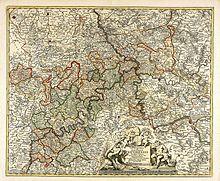
Back Trir kürfürstlüyü Azerbaijani Трырскае курфюрства Byelorussian Курфюрство Трир Bulgarian Trevírské kurfiřtství Czech Kurfyrstendømmet Trier Danish Kurtrier German Εκλεκτοράτο της Τριρ Greek Elektoprinclando Treviro Esperanto Electorado de Tréveris Spanish Trieri kuurvürstkond Estonian
This article needs additional citations for verification. (December 2015) |
Electorate of Trier | |||||||||||||
|---|---|---|---|---|---|---|---|---|---|---|---|---|---|
| 898–1801 | |||||||||||||
 The Electorate of Trier in 1720 | |||||||||||||
| Status | State of the Holy Roman Empire | ||||||||||||
| Capital | Trier, Ehrenbreitstein | ||||||||||||
| Common languages | |||||||||||||
| Religion | Catholic Church | ||||||||||||
| Government | Prince-Bishopric | ||||||||||||
| Elector of Trier | |||||||||||||
• 1768–1803 | Prince Clemens Wenceslaus of Saxony | ||||||||||||
| Historical era | |||||||||||||
• Autonomy granted | 772 | ||||||||||||
| 898 | |||||||||||||
• Raised to electorate | between 1189 and 1212 | ||||||||||||
| 1212 | |||||||||||||
• Joined Electoral Rhenish Circle | 1512 | ||||||||||||
| 9 February 1801 | |||||||||||||
| 9 June 1815 | |||||||||||||
| |||||||||||||




The Electorate of Trier (German: Kurfürstentum Trier or Kurtrier or Trèves) was an ecclesiastical principality of the Holy Roman Empire that existed from the end of the 9th to the early 19th century. It was the temporal possession of the prince-archbishop of Trier (Erzbistum Trier) who was, ex officio, a prince-elector of the empire. The other ecclesiastical electors were the electors of Cologne and Mainz.
The capital of the electorate was Trier; from the 16th century onward, the main residence of the Elector was in Koblenz. The electorate was secularized in 1803 in the course of the German mediatisation.
The Elector of Trier, in his capacity as archbishop, also administered the Archdiocese of Trier, whose territory did not correspond to the electorate (see map below).

